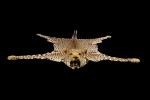Hooded Crow – Corvus cornix
Hooded Crow – Corvus cornix
This crow is considered a subspecies of the black crow, which has the same shape and morphology. Head, upper chest, wings, tail and shins are black, the rest of the plumage is gray. It is a noisy bird.
Its repertoire is hardly varied and consists mainly of harsh croaks. Although their distribution space does not overlap in a few places or if their cohabitation is done only during restricted periods in particular for winter migration, habitat hooded crow is not very different that of crows because their feeding and nesting requirements are not very far away basically. Therefore found in forest edges and clearings, in agricultural areas with trees and bushes and in urban parks, altitude moorland or coastal cliffs. It is not uncommon on the mudflats of estuaries and shorelines. It is present in most of Europe, except the south of France and the Iberian Peninsula.This is a partial Migrator. European populations migrate to the western and southern coasts, from the end of September and the return takes place in mid-February or early March. Couples stay together for several years. The nest is always isolated, on a tree or in a low bush, it regularly returns in its territory and often reoccupied its former nest. It is made of dry branches, padded tufts of grass, mud, with an internal cutting thin twigs, moss and hair. Both sexes participate in the construction. In April and May, the female lays 4 to 6 eggs, which she incubates alone. The young remain in the nest 32 days.
Unlike the black crow, it eats fewer eggs, fewer small rodents and young chicks. It is looking for bodies in the meadows where cattle presence makes soils with excrement. It also consumes some plant material: seeds, nuts, fruits, berries, poppy heads.





